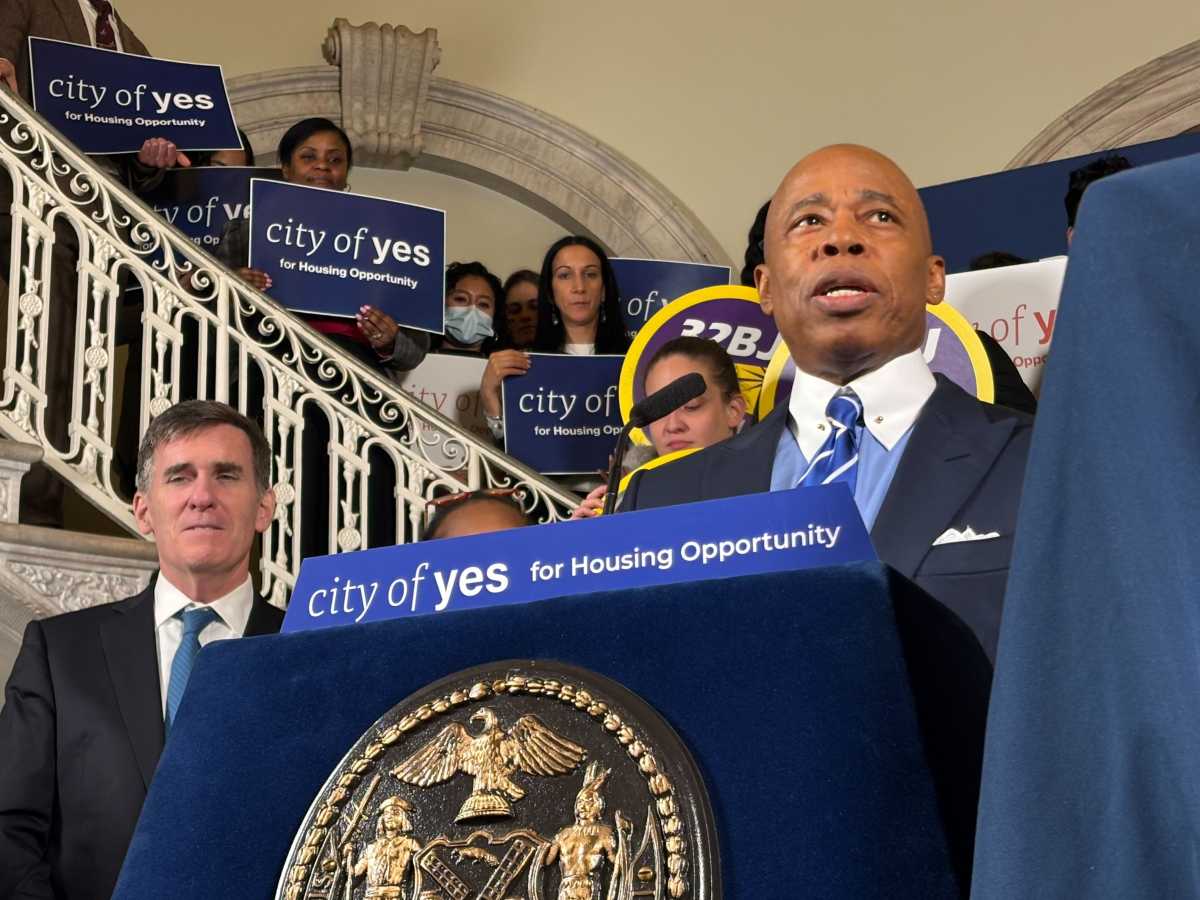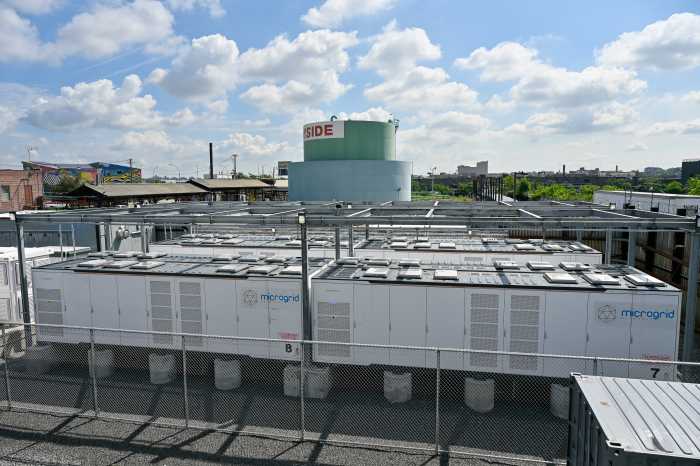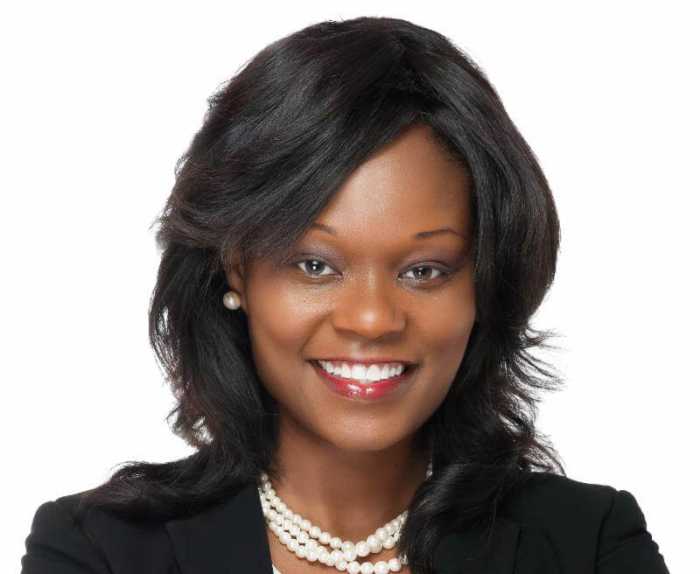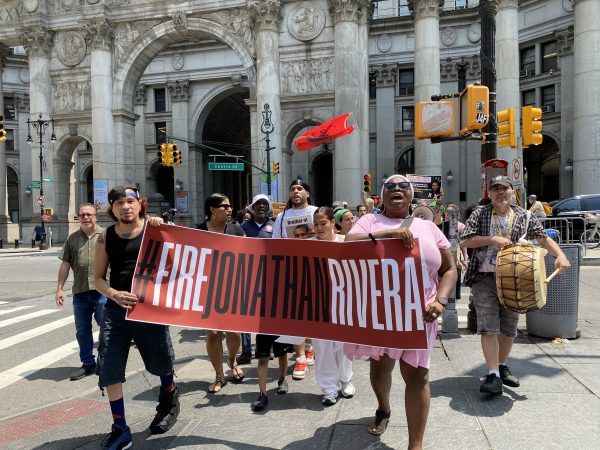A top official with a German shipping company that took its $1.6 billion
trade deal to New Jersey after first considering Brooklyn’s port,
said this week that the decision came down to the city’s refusal
to back the Red Hook port’s existence.
“There’s usually other factors that are in play, but it is correct
that the lack of a long-term lease agreement affected our decision,”
Rainer Dehe, chief of operations for the international shipping company
Hamburg Sud told the Brooklyn Papers this week. The company had hoped
to ship to Brooklyn for the next five years at the Red Hook piers operated
by American Stevedoring Inc. (ASI), promising the creation of 400 jobs
here, he said.
The Brooklyn Papers first reported last
week that the company instead signed a contract with a port in Bayonne,
N.J., after city Economic Development Corporation officials refused to
guarantee that the Red Hook port would remain open through 2009.
“It was definitely a factor that they have only a relatively short
contract that extends only to 2007,” added Dehe.
After extensive negotiations, the Port Authority of New York and New Jersey
last December granted ASI a three-year lease extension on piers 7 through
10, claiming piers 11 and 12 for conversion to a cruise ship port.
“That certainly hasn’t helped [ASI] in securing long-term contracts,”
said Dehe. “As a shipping line, we want to be sure that we have a
terminal in five to 10 years, maybe even 20 years. Seeing as terminals
everywhere are filling up very quickly, if we transferred our ships to
Brooklyn we’d end up without a place to go when their lease expired.”
But, he added, “it certainly makes sense from our position to maintain
a viable active port in Brooklyn,” given its proximity to truck routes,
buyers, adequate water depth for docking large freighters and the international
reputation of ASI’s shipping container unloading operation.
“The operator of the terminal has a good reputation as somebody who
is managing operations efficiently and fast,” Dehe said of ASI.
Though Dehe wouldn’t say whether the Brooklyn port was the shipping
giant’s first choice, he said Hamburg Sud had “many meetings
about signing an agreement with them.”
“They were in competition with several other major terminals in the
port of New York and New Jersey for this contract,” he said. “They
were on our short list.”
Instead of concern over the commerce lost to New Jersey, a spokeswoman
for the Economic Development Corporation (EDC) expressed optimism that
the cruise lines planned for Piers 11 and 12 were hopefully going to expand
into the ASI port.
“We have said in testimony that we think there will be a need for
a fifth berth within the next five years, and we’ve identified Pier
10 for that purpose,” said EDC spokeswoman Janel Patterson, who added,
“We support industrial use for piers 7, 8, 9a and 9b.”
Asked why EDC Vice President Kate Ascher did not express that support
to Hamburg Sud when asked to do so in a letter, she said, “We support
industrial uses along those piers, but we don’t control the piers,
so we can’t control what will be going there in five years. We can’t
sign a letter guaranteeing anything on property that we do not control.”
The EDC, however, has for the past two years been working with the Port
Authority, in a lead role, to plan the future of piers 6 through 12, which
run from Atlantic Avenue down to Pioneer Street in Red Hook. Bringing
the Carnival and Norwegian cruise lines to piers 11 and 12 was part of
that effort, as was turning Pier 6 over to the planned Brooklyn Bridge
Park.
According to ASI CEO Christopher Ward, the EDC does control the port’s
destiny. All the German shipper was looking for was encouragement to bring
their business to Brooklyn, he said, not a guarantee.
“All Hamburg Sud wanted was a simple indication from the city that
they were welcome in Brooklyn, given that they felt that EDC was setting
the policy for the Brooklyn waterfront. They were seeking clarification
of the city’s plan,” he said.
Ward worked for the Port Authority prior to serving as Mayor Michael Bloomberg’s
Environmental Protection commissioner. He left the administration last
October to take over ASI.
The mayor’s office declined to comment for this article.
ASI executives say the Red Hook container port currently employs 600 New
Yorkers, which include drivers, maintenance crews, crane operators and
longshoremen.
Unlike the Staten Island facility, which the EDC contends is where the
400 jobs lost to New Jersey will eventually wind up, the Brooklyn port
was ready to take the account.
Both Hamburg Sud’s Dehe, and the CEO of the New York Container Port
in Staten Island’s Howland Hook, this week agreed that the Staten
Island port would need an overhaul to accommodate container ships.
“When Hamburg Sud indicated that they were going to change piers,
[after their contract with a carrier line in New Jersey ended] they said
they were interested in coming here,” explained Jim Devine, chief
of operations at the New York Container Terminal, which also owns Global
Terminal, the New Jersey port where Hamburg Sud will now unload its freighters.
“I said ‘Well, we don’t have [a deep enough channel], we
won’t have water this year, or until the very end of next year.’”
The Howland Hook port is currently only 35 feet deep, and according to
Devine, the container ships need 39- to 40-foot depths in order to dock.
The Army Corps of Engineers is dredging the surrounding waterway to reach
a 43-foot depth, using money allocated by the city.
Devine said the “temporary” port at Bayonne, where Hamburg Sud
signed a five-year operating agreement, is 45 feet deep.
“New York Harbor enjoys naturally deep water. You don’t hit
bedrock until over 50 feet. We could’ve accommodated Hamburg Sud’s
vessels immediately,” said ASI spokesman Matt Yates.
At Howland Hook, said Devine, 80 percent of the 475 workers live in New
York City, with 90 from Brooklyn, 280 from Staten Island and 12 from the
Bronx, Manhattan and Queens.
That port has a long-term lease with the Port Authority, which although
set to expire in 2019, according to Devine, is in the process of being
granted an extension through 2030.
Staten Island hopes to accommodate Hamburg Sud by late 2006, at which
point the company is expected to ink a five-year contract with the city.
In the meantime, the trade and jobs go to New Jersey.
Heineken beer, which Devine said was “the single largest commodity”
in the city, costs “less than a penny [per bottle to ship], thanks
to containerization.”
“That’s the positive side — goods are cheaper because transportation
is so efficient, the ships are bigger, you can move more cargo with less
people on less piers,” said Devine.
“A container ship used to come into port five, six days; now it comes
in for 10 to 12 hours,” said Devine, noting the monetary savings
of the expedited shipping process. “The bad side is, unfortunately,
it obsolesces some of the smaller piers.”
But Dehe said that efficiency was what drew his company’s interest
in porting in Brooklyn with ASI.
“The time in port is expensive, and we try to keep it brief as possible,”
said Dehe. “They brought to us what was a very attractive offer,
but in the end, because of the lease expiration we had to look elsewhere.”
Asked why the EDC was able to lure cruise lines to the Red Hook port,
and secure lease agreements on those piers, but was unwilling to do so
for the container ports, Patterson said, “It was a specific project
we were working on.”
Patterson insisted, “The jobs are coming to New York. The understanding
is that they would be there when the channel was deep enough,” she
said, but added, “I don’t know the terms of their agreement.”
As to the long-term, Dehe told The Brooklyn Papers, “We indeed are
planning to transfer the service to Staten Island, but that is some time
away, we don’t have a fixed timeline for that and it’s not going
to be within the next couple of months. Maybe the end of this year, maybe
early next year, but again, that’s all tentative, and it depends
on some external factors.”
Asked about the city’s turning away port business for Brooklyn, Councilman
David Yassky, who chairs the waterfronts committee, said, “We’ve
had three hearings in the City Council about this. At every one [the EDC]
won’t say it directly wants to get rid of 300 jobs, but putting cruise
in place of the industrial waterfront is what the administration’s
policy has been.”






















